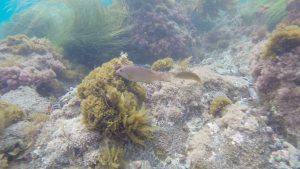
The keystone of an arch is the center stone that holds the whole structure together. If that one stone is shifted, the entire archway will no longer be able to hold its shape. Similarly, a keystone species is a species that plays a very influential role in maintaining the balance of an ecosystem. If it is taken out of its environment, the ecosystem it leaves behind will take on a drastically different structure.

A common example of a keystone species in the Pacific Northwest is the sea otter. Sea otters are marine mammals that feed on sea urchins, crabs, abalone, and other shelled animals. Because a sea urchin’s favorite foods are kelp holdfasts and other algae, it is important for their population levels to be regulated so overgrazing does not occur. As the primary predator of sea urchins, sea otters ensure that urchin population levels never get too high. However, sea otters have faced several obstacles to their survival over the years. Overhunting in the 1800s completely wiped out otter populations in Southern California, and today Northern California otters continue to face threats from fishing practices, pollution, and predatory changes. As sea otter populations continue to decrease in some areas, “urchin barrens” have been found dotting parts of the ocean floor. These are created when urchin populations get too high and start to eat every piece of algae in sight, taking down whole kelp forests in their search for more food. Without the kelp to hide in and feed on, fish move on to other places, leaving only a barren wasteland of hungry urchins behind. The habitat collapses when the sea otter is not there to maintain its healthy balance.
 The California Sheephead is a keystone species that stops urchin barrens from happening in the waters around Catalina. Just like otters, Sheephead’s love to feed on those algae-loving echinoderms. Their sharp teeth are perfectly suited to breaking through the urchin’s spines and hard exoskeleton. However, also like otters, the California Sheephead faces its own set of challenges for survival. Commercial and recreational fishing have given it a vulnerable population status, which has led to higher restrictions being placed in recent years on the size and amount of the fish that can be taken. Due to the important role it plays in Catalina’s ocean ecosystem, we can only hope that the California Sheephead continues to thrive in these waters for many years to come.
The California Sheephead is a keystone species that stops urchin barrens from happening in the waters around Catalina. Just like otters, Sheephead’s love to feed on those algae-loving echinoderms. Their sharp teeth are perfectly suited to breaking through the urchin’s spines and hard exoskeleton. However, also like otters, the California Sheephead faces its own set of challenges for survival. Commercial and recreational fishing have given it a vulnerable population status, which has led to higher restrictions being placed in recent years on the size and amount of the fish that can be taken. Due to the important role it plays in Catalina’s ocean ecosystem, we can only hope that the California Sheephead continues to thrive in these waters for many years to come.


